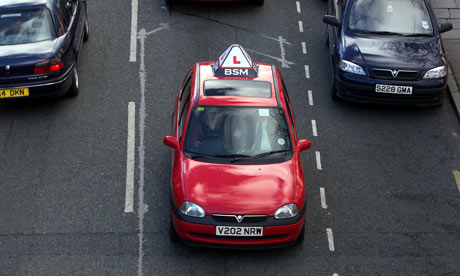An American tribute to British drivers
I have newfound respect for all the motorists I encounter on British roads.

An experienced driving instructor can earn £35,000 a year. Photograph: Christopher Thomond
The United States and the United Kingdom have many important similarities, but a rigorous driving test is not one of them. As an American who recently passed the UK driving theory and practical tests, I have newfound respect for all the motorists I encounter on British roads.
To get my American license when I was 16 years old, I had to take a very short multiple choice theory test. Having not studied and never driven, I passed easily. Then I took a practical test that consisted of a 15-minute amble through a flat rural area. I performed poorly, and at the end of my test the examiner turned to me and said, "You really don't know what you're doin', do ya?" And he passed me.
I initially assumed the UK test was comparable to the one across the pond. But then I read that the large majority of UK motorists fail their first driving exam. And I heard horror stories of Americans and other foreigners failing multiple times. I began to study (or "revise" as you Brits say) in earnest.
I'm a doctoral student at Cambridge, and I'm quite sure I prepared much more for my driving tests than I will for my PhD viva next year.
A UK license is basically a PhD in driving.
I read the Highway Code. I read the entire 528-page AA Complete Test book, reviewing all of its 948 multiple-choice questions. I bought the Driving Test Success DVD, watching hours of slightly awkward inside-the-car footage of UK driving lessons. I watched countless "hazard perception" videos on YouTube.
The night before my practical test I fell asleep around 2am on my sofa with my laptop on my stomach as I watched "show me, tell me" vehicle safety tutorials. Had I not watched those videos, my answer to every vehicle safety question during the real test would have been "I would call my dad and then call AA."
(Note to American readers: AA is the British equivalent of AAA, but for some reason they don't call it the "American Automobile Association" in the UK.)
In the course of my studies I had to learn all those charming British motoring terms. To me, many of the terms sounded more like names for rock and folk bands. You know, when I was a teenager I loved heavy metal bands like Kerb, Slip Road, and MOT, and punk bands like The Rising Bollards. Now that I'm older, I prefer the gentler acoustic sound of bands like Soft Verge, Central Reservation, Pelican Crossing, Gantry Sign, and Urban Clearway, though I can still dig the pop-punk energy of Double Mini Roundabout.
I also had to create mnemonic devices to remember the differences between Britain's bird-name road crossings. A toucan crossing is where "two can" cross – both pedestrians and cyclists. At a puffin crossing, a pedestrian may be "huffin' and puffin' to get across" because there is no flashing amber light. Oh, apparently "amber" means "yellow" in English English. I've taken to calling Britain's other traffic lights ruby and emerald.
Thanks to my preparation, I passed the theory test, though my hazard perception score was hazardously low.
When the moment of my practical test arrived, I was a nervous wreck – though thankfully not a literal wreck. I tried to endear myself to my stiff-upper-lipped examiner by noting that the driving tests in America are "a bit different". He chuckled and said, "they're a joke".
To be fair to Americans, we drive big automatic cars on wide, open, straight roads, and most of our country is farmland and wilderness. Most of our towns and cities were laid out after the invention of the automobile. America is a car-based civilization. A Declaration of Independence from public transportation is part of our national psyche. A burdensome license test would be seen as an infringement on our fundamental human right to drive.
Things are "a bit different" in Britain. You have eight times the population density of the United States and many of your narrow, windy roads were developed before the invention of even the horse-drawn coach.
My American compatriots are shocked when I tell them that to earn a UK license I had to take a lengthy theory test, computerized hazard perception test, eye sight test, vehicle safety test, and a 40-minute driving test with a meticulous examiner jotting down each of my "faults" in real time.
As my faults mounted during the test, I prayed that we would turn back toward the test centre before I surpassed the maximum level of acceptable faultiness. I'm a married homeowner who drives an MPV with two toddlers in car seats; I'm hardly a risk-taker on the road. But I am an American. The examiner perceived my hazardousness and marked me down for not looking in my mirrors before I signalled – seven times.
Now I'm always conscious of looking in the mirrors before I signal and manoeuvre. Thanks to the rigors of the UK driving test, I'm a much safer driver, and I'm glad that I share the road with a nation of drivers who had to pass the same demanding test.
The people of Great Britain can be rightfully proud of their great driving skills. Whereas the easy US tests make me wary of American drivers, here in the UK, I've embraced the mantra Keep Calm and Drive On.
